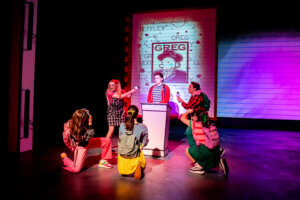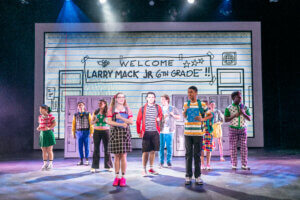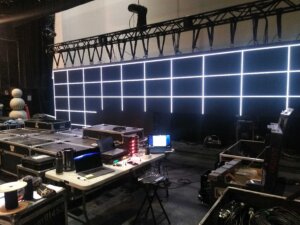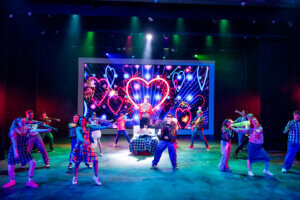
Mindleader Message in A Charlie Brown Christmas Live on Stage
What Charlie Brown Teaches Us About Honesty, Connection, and Support...
Learn MoreOrlando Family Stage
The Finest in Family Theater
Hear about the collaboration between Cindy White, Tim Brown, and Justin Harmon and see their design in action at the family-friendly Diary of a Wimpy Kid the Musical here through April 20, 2025.
When the lights come up on Diary of a Wimpy Kid the Musical, audiences are not just stepping into Greg Heffley’s world; they are stepping into his mind. A hyper-stylized blend of simple line art, animated projections, and physical set pieces transform the stage into a live-action diary. The result? A storytelling experience that looks like a cartoon but feels deeply human.
This creative feat did not happen by accident. It was the result of meticulous planning, constant collaboration, and a little bit of theatrical magic engineered by Scenic Designer Cindy White, Projections and Video Designer Tim Brown, and Director of Production Technology Justin Harmon and his team. Together, they did not just build a set, they built a visual language!
The first challenge? How to translate Jeff Kinney’s signature stick-figure aesthetic into a three-dimensional theatrical world.

“Jeff Kinney’s hyper-simple line art drawing style is a wonderful backdrop to overlay vibrant costuming and lighting,” said scenic designer Cindy White. “Scenery and projections were the perfect fit to take up the mantle of the black and white world and allow the color to fly in the cast and show lighting.”
But what may look simple on the page is deceptively complex onstage. The production required constant location shifts, from school hallways to bedrooms to a middle-school talent show stage. Each scene had to unfold at the speed of thought, mimicking the way Greg might flip from one diary page to the next.
“Scene changes are thoughts in Greg’s diary,” Cindy explained. “We needed to be able to flip in and out of the settings quicker than traditional scene changes.”
That storytelling need led Tim Brown to a bold idea: What if they used a video wall?
“I think in a meeting I started to say, ‘To make this look really good we need a video wall,'” Tim recalled. “When I said that I was thinking, ‘But there is no way we could do that.’ But then I remembered that UCF had a video wall that we could use. And the rest is history.”

This marked the first time Orlando Family Stage used a full LED video wall in a mainstage production; a testament to the team’s willingness to explore new tools in service of storytelling.
Tim was not just excited about speed. He saw an opportunity to elevate the show’s aesthetic. The black-line-on-white style of the books is incredibly hard to replicate using traditional projectors. “A video wall is like a big TV,” he said. “We can get away with a white background that isn’t too bright, which makes the black lines pop out.”
Still, the leap from idea to execution was anything but simple.
Justin Harmon, Director of Production Technology, stepped in to make the video wall a reality, even though the wall they had access to was far from state-of-the-art.
“The video wall we used was originally manufactured in 2011,” Justin explains. “It’s older tech, with a proprietary cable system. We had just enough cables to build the wall to the size the creative team envisioned—but barely.”
If that sounds complex, it is because it was. Think of the video wall as a giant digital puzzle made of dozens of glowing tiles, each needing power and a perfect video signal. The catch? This puzzle had outdated pieces and a limited instruction manual. Justin had to bring in a power distribution unit (or “power distro”) to feed 24 circuits of electricity—roughly equivalent to powering every appliance in your house at once. He then rigged the wall in midair using a truss system and three one-ton chain hoist motors—basically, industrial-grade lifts used to suspend the enormous structure above the stage.

The tech challenge did not stop there. Because the older LED wall could not daisy-chain all the panels together under one processor, Justin had to use four separate processors to control different sections of the image. To coordinate them, he added a Datapath display controller—a specialized computer that split the video content into perfect quadrants. Picture slicing a movie into four exact pieces and then projecting each slice to a different screen, all while keeping it in perfect sync.
“It all worked out,” Justin says, “but there are much easier and simpler processes with modern LED walls.” It was a classic case of making theatre magic with what you have, not just despite limitations, but because of them.
Despite the hurdles, the payoff was breathtaking. “The ‘wow’ moment for me was when we finally had everything running and played a video for the first time,” Justin recalls. “It was so bright we had to set the brightness to its lowest setting just so it wouldn’t overpower the stage lights.”
In many ways, the video wall became its own lighting instrument, another layer of storytelling that required careful choreography with the scenic design and lighting cues. It was cutting-edge tech, used not just for spectacle but to honor the heart and humor of a beloved story.
From the start, Cindy and Tim approached the visual storytelling as a true partnership.
“Pretty much right away,” Cindy said. “I offered to take on setting the ‘background’ settings we used and started some of the key character art. Tim noted all the opportunities he might be able to animate images, fly and spin things in and out… he ‘staged and choreographed’ all the projection images we both generated.”

Their workflow was a model of creative collaboration. Cindy would sketch out environments such as a school hallway, Greg’s bedroom, or a chaotic talent show. Then, Tim would animate them, adding motion, pacing, and surprise.
“Cindy created the world, and I got to bring it to life and add motion and texture to it,” Tim said. “I also was able to interact with the lighting designer, Ben Lowe. Again, the video wall is really one big light. I was inspired by the lights and tried to match colors or adjust the image on the screen to blend in.”
That synergy paid off in countless memorable moments. From the dancing Joshie poster to the Citizen Kane-style “Greg press conference,” the blend of analog and digital evoked laughter, nostalgia, and heart.
Of course, the process came with its share of trial and error.
Tim went through over a dozen background textures before finding one that looked like paper but did not blow out on the video wall. He struggled to make a classroom map scroll down convincingly. Cindy spent hours perfecting parody posters and joke illustrations. And Justin? He juggled outdated tech with forward-thinking ambitions.
But every challenge brought discovery. In many ways, every glitch or misfire became a design experiment, proof that innovation does not happen in a straight line.

“The Animal Heart sequence was really fun and really challenging,” Tim said. “Getting to create a concert-like sequence was tons of fun… I love how it ends. It is very funny.”
“Throwing sketches and line art in our shared folder and then seeing them turn into magic at the rehearsals… it was so much better than I had imagined,” Cindy added. “And that is the best feeling.”
The success of Diary of a Wimpy Kid the Musical at Orlando Family Stage was not just about laughs and catchy songs. It was a triumph of design thinking, technical wizardry, and authentic collaboration.
Behind every dance break and diary confession was a trio of creatives dreaming in line art and thinking in pixels. And thanks to their work, Greg Heffley’s doodled world did not just come alive, it felt real.
Their advice for young designers? Be curious. Try things. Do not be afraid to make something weird. Find mentors. Start building your own inspiration library. Gather images, references, and sketches that catch your eye. You never know when they will spark your next great idea!
Don't miss out on the magic. Grab your tickets now and
make unforgettable memories at Orlando Family Stage!